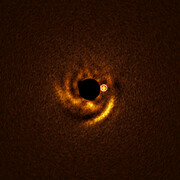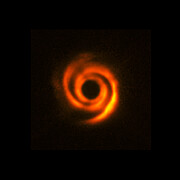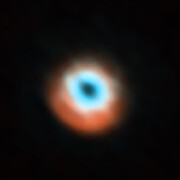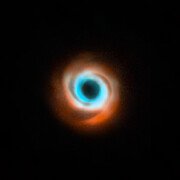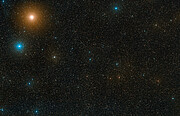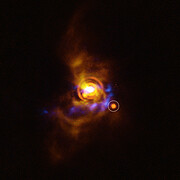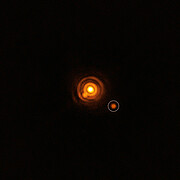Komunikat prasowy
Astronomowie obserwują, jak nowo narodzona gwiazda rzeźbi otaczający ją pył
21 lipca 2025
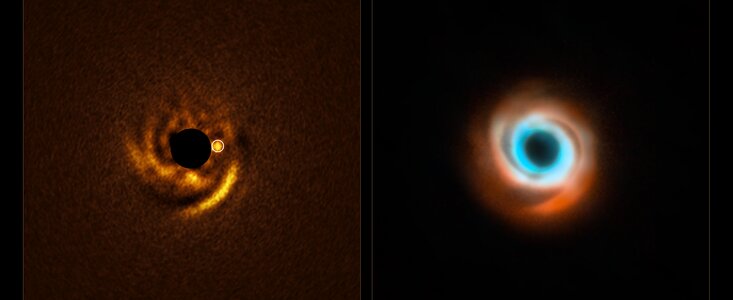
Astronomowie uchwycili prawdopodobnie w akcji wciąż formującą się planetę, tworzącą skomplikowany wzór w gazie i pyle, który otacza młodą gwiazdę macierzystą. Przy pomocy Bardzo Dużego Teleskopu (VLT), należącego do ESO, obserwowali dysk planetarny z widocznymi ramionami spiralnymi, znajdując wyraźne oznaki, iż w jego wewnętrznym rejonie zagnieździła się planeta. To pierwszy raz, gdy astronomowie wykryli kandydatkę na planetę schowaną wewnątrz dysku spiralnego.
“Nigdy nie będziemy świadkami powstawania Ziemi, ale w tym miejscu, wokół młodej gwiazdy odległej o 440 lat świetlnych, możemy w czasie rzeczywistym świadkami powstawania planety” mówi Francesco Maio, doktorant na University of Florence we Włoszech, pierwszy autor nowych badań opublikowanych dzisiaj w Astronomy & Astrophysics.
Potencjalna rodząca się planeta została wykryta wokół gwiazdy HD 135344B, w dysku gazu i pyłu wokół, zwanym dyskiem protoplanetarnym. Pączkująca planeta jest szacowana na dwukrotny rozmiar Jowisza, a odległość od gwiazdy odpowiadająca pozycji Neptuna względem Słońca. Zaobserwowano, jak obiekt kształtuje swoje otoczenie w dysku protoplanetarnym w miarę wzrostu do w pełni ukształtowanej planety.
Wokół innych młodych gwiazd obserwowano już dyski protoplanetarne, często wykazują one skomplikowane wzory, takie jak pierścienie, przerwy, spirale. Astronomowie od dawna przewidują, że takie struktury są spowodowane przez niemowlęce planety, które zgarniają materię w trakcie krążenia wokół gwiazdy macierzystej. Ale, jak dotąd, nie udało się uchwycić takiego planetarnego rzeźbiarza w akcji.
W przypadku dysku HD 135344B, wcześniej wykryto wirujące ramiona, czego dokonał inny zespół, używając SPHERE (Spectro-Polarimetric High-contrast Exoplanet REsearch), instrumentu na teleskopie VLT. Jednak żadne z wcześniejszych obserwacji tego systemu nie natrafiły na dowód, iż w dysku formuje się planeta.
Teraz, dzięki obserwacjom z nowego instrumentu Enhanced Resolution Imager and Spectrograph (ERIS) na VLT, badacze mówią, że być może znaleźli główną podejrzaną. Zespół dostrzegł kandydatkę na planetę tuż u podstawy jednego z ramion spiralnych dysku, dokładnie tam, gdzie teoria przewiduje, iż można poszukiwać planety odpowiedzialnej za rzeźbienie takiego wzoru.
„Tym, co czyni niniejszą detekcję potencjalnie punktem zwrotnym, w przeciwieństwie do wielu wcześniejszych obserwacji, jest fakt, iż jesteśmy w stanie bezpośrednio wykryć sygnał od protoplanety, która ciągle jest mocno zanurzona w dysku” tłumaczy Maio, którego instytucją jest Arcetri Astrophysical Observatory, ośrodek włoskiego National Institute for Astrophysics (INAF). „Daje nam to znacznie wyższy poziom pewności co do istnienia planety, ponieważ obserwujemy własne światło planety.”
Rodzi się towarzysz gwiazdy
Kolejny zespół astronomów użył ostatnio instrumentu ERIS do obserwacji innej gwiazdy, V960 Mon, jednej z tych, które wciąż są na wczesnych etapach swojego życia. W badaniu opublikowanym 18 lipca w The Astrophysical Journal Letters, grupa raportuje, że odnalazła towarzyszący młodej gwieździe obiekt. Dokładna natura tego obiektu pozostaje zagadką.
Nowe badania, kierowane przez Anuroopa Dasguptę, doktoranta w ESO oraz na Diego Portales University w Chile, stanową kontynuację obserwacji V960 Mon wykonanych kilka lat wcześniej. Obserwacje te, wykonane zarówno przez SPHERE, jak i Atacama Large Millimeter/submillimeter Array (ALMA), ujawniły, iż materia orbitująca wokół V960 Mon ma kształt serii skomplikowanych ramion spiralnych. Pokazano także, że materia ulega fragmentacji w procesie znanym jako „niestabilność grawitacyjna”, gdy duże skupiska materii wokół gwiazdy zapadają się, każde z potencjałem na uformowanie się planety albo innego dużego obiektu.
„Praca ta ujawniła niestabilną materię, ale pozostawiła otwarte pytanie, co stanie się potem. Dzięki ERIS postanowiliśmy znaleźć zwarte, jasne fragmenty sygnalizujące występowanie towarzyszki w dysku – i to się udało” wskazuje Dasgupta. Zespół znalazł prawdopodobny obiekt towarzyszący bardzo blisko jednego z ramion spiralnych obserwowanych przez SPHERE i ALMA. Badacze mówią, że obiekt może być albo powstającą planetą, albo brązowym karłem – obiektem większym niż planeta, ale nie mającym wystarczającej masy, aby zaświecić jako gwiazda.
Po potwierdzeniu, towarzyszący obiekt może być pierwszą wyraźną detekcją planety lub brązowego karła formującego się z niestabilności grawitacyjnej.
Więcej informacji
Badania opisane w pierwszej części niniejszego komunikatu zostały zaprezentowane w artykule pt. „Unveiling a protoplanet candidate embedded in the HD 135344B disk with VLT/ERIS”, który ukaże się w Astronomy & Astrophysics (doi: 10.1051/0004-6361/202554472). Druga część komunikatu opiera się na badaniach pt. “VLT/ERIS observations of the V960 Mon system: a dust-embedded substellar object formed by gravitational instability?” opublikowanych w The Astrophysical Journal Letters (doi: 10.3847/2041-8213/ade996).
Skład zespołu pierwszego badania (HD 135344B): F. Maio (University of Firenze, Włochy i INAF-Osservatorio Astrofisico Arcetri, Firenze, Włochy [OAA]), D. Fedele (OAA), V. Roccatagliata (University of Bologna, Włochy [UBologna] i OAA), S. Facchini (University of Milan, Włochy [UNIMI]), G. Lodato (UNIMI), S. Desidera (INAF-Osservatorio Astronomico di Padova, Włochy [OAP]), A. Garufi (INAF - Istituto di Radioastronomia, Bologna, Włochy [INAP-Bologna] i Max-Planck-Institut für Astronomie, Heidelberg, Niemcy [MPA]), D. Mesa (OAP), A. Ruzza (UNIMI), C. Toci (European Southern Observatory [ESO], Garching bei Munchen, Niemcy i OAA), L. Testi (OAA i UBologna), A. Zurlo (Diego Portales University [UDP], Santiago, Chile i Millennium Nucleus on Young Exoplanets and their Moons [YEMS], Santiago, Chile) oraz G. Rosotti (UNIMI).
Skład zespołu drugiego badania (V960 Mon): główna część zespołu to członkowie Millennium Nucleus on Young Exoplanets and their Moons (YEMS), współpracy badawczej z siedzibą w Chile. Głównymi autorami z YEMS są: A. Dasgupta (ESO, Santiago, Chile, UDP i YEMS), A. Zurlo (UDP i YEMS), P. Weber (University of Santiago [Usach], Chile, YEMS oraz Center for Interdisciplinary Research in Astrophysics and Space Exploration [CIRAS], Santiago, Chile), F. Maio (OAA i University of Firenze, Włochy), Lucas A. Cieza (UDP i YEMS), D. Fedele (OAA), A. Garufi (INAF Bologna i MPA), J. Miley (Usach, YEMS iCIRAS), P. Pathak (Indian Institute of Technology, Kanpur, Indie), S. Pérez (Usach, YEMS i CIRAS) oraz V. Roccatagliata (UBologna i OAA).
Atacama Large Millimeter/submillimeter Array (ALMA) jest międzynarodowym kompleksem badawczym w ramach partnerstwa pomiędzy ESO, U.S. National Science Foundation (NSF) oraz National Institutes of Natural Sciences (NINS) of Japan, we współpracy z Chile. ALMA jest finansowana przez ESO w imieniu Krajów Członkowskich, przez NSF we współpracy z National Research Council of Canada (NRC) i National Science Council of Taiwan (NSC) oraz przez NINS we współpracy z Academia Sinica (AS) na Tajwanie i Korea Astronomy and Space Science Institute (KASI). Budowa i zarządzanie ALMA są kierowane przez ESO w imieniu Krajów Członkowskich, przez National Radio Astronomy Observatory (NRAO), zarządzane przez Associated Universities, Inc. (AUI), w imieniu Ameryki Północnej oraz przez National Astronomical Observatory of Japan (NAOJ) w imieniu Azji Wschodniej. Joint ALMA Observatory (JAO) umożliwia zunifikowane kierowanie i zarządzanie budową, testowaniem i działaniem ALMA.
Europejskie Obserwatorium Południowe (ESO) umożliwia naukowcom z całego świata na odkrywanie tajemnic Wszechświata z korzyścią dla nas wszystkich. Projektujemy, budujemy i zarządzamy światowej klasy obserwatoriami naziemnymi – których astronomowie używają do odpowiadania na ciekawe pytania i szerzenia fascynacji astronomią – a także promujemy międzynarodową współpracę w astronomii. Ustanowione w 1962 roku jako organizacja międzynarodowa, ESO jest wspierane przez 16 krajów członkowskich (Austria, Belgia, Czechy, Dania, Finlandia, Francja, Hiszpania, Irlandia, Holandia, Niemcy, Polska, Portugalia, Szwajcaria, Szwecja, Wielka Brytania oraz Włochy), a także Chile jako kraj gospodarz, oraz Australię jako strategicznego partnera. Siedziba ESO, a także jego centrum popularyzacji nauki i planetarium (ESO Supernova) znajdują się w pobliżu Monachium w Niemczech, natomiast chilijska pustynia Atakama – niesamowite miejsce z wyjątkowymi warunkami do obserwacji nieba – jest domem dla naszych teleskopów. ESO zarządza trzema lokalizacjami obserwacyjnymi w Chile: La Silla, Paranal i Chajnantor. W Paranal ESO posiada teleskop VLT (Very Large Telescope – Bardzo Duży Teleskop) oraz dwa teleskopy do przeglądów nieba. VISTA pracuje w podczerwieni, VLT Survey Telescope w zakresie widzialnym. W Paranal ESO zarządza także południowym obserwatorium CTA (Cherenkov Telescope Array South) – największym na świecie i najbardziej czułym obserwatorium promieniowania gamma. Wspólnie z międzynarodowymi partnerami ESO zarządza także radioteleskopami APEX i ALMA, które są instrumentami do obserwacji nieba w zakresach milimetrowym i submilimetrowym. Na Cerro Armazones, niedaleko Paranal, budujemy „największe oko świata na niebo”, czyli Ekstremalnie Wielki Teleskop (Extremely Large Telescope, ELT). Nasza działalność w Chile jest zarządzana z biur ESO w Santiago, gdzie współpracujemy też z chilijskimi partnerami.
Linki
- Publikacja naukowa (Maio et al., on HD 135344B)
- Publikacja naukowa (Dasgupta et al., on V960 Mon)
- Zdjęcia VLT
- Dla dziennikarzy: subscribe zasubskrybuj, aby otrzymywać w swoim języku nasze komunikaty z embargo
- Dla naukowców: jeśli masz ciekawy temat, zgłoś swoje badania
- New ESO analysis confirms severe damage from industrial complex planned near Paranal
Kontakt
Francesco Maio (for questions on the HD 135344B study)
INAF Osservatorio Astrofisico di Arcetri
Florence, Italy
E-mail: francesco.maio@inaf.it
Davide Fedele (for questions on the HD 135344B study)
INAF Osservatorio Astrofisico di Arcetri
Florence, Italy
Tel.: (+39) 055-2752-242
E-mail: davide.fedele@inaf.it
Anuroop Dasgupta (for questions on the V960 Mon study)
European Southern Observatory
Santiago, Chile
E-mail: Anuroop.Dasgupta@eso.org
Bárbara Ferreira
ESO Media Manager
Garching bei München, Germany
Tel.: +49 89 3200 6670
Tel. kom.: +49 151 241 664 00
E-mail: press@eso.org
Krzysztof Czart (Kontakt dla mediów Polska)
Sieć Popularyzacji Nauki ESO
oraz Urania - Postępy Astronomii
Toruń, Polska
Tel.: +48 513 733 282
E-mail: eson-poland@eso.org
O komunikacie
| Komunikat nr: | eso2513pl |
| Nazwa: | HD135344B, V960 Mon |
| Typ: | Milky Way : Star : Circumstellar Material : Disk : Protoplanetary |
| Facility: | Very Large Telescope |
| Instrumenty: | ERIS |
| Science data: | 2025ApJ...988L..30D 2025A&A...699L..10M |
Our use of Cookies
We use cookies that are essential for accessing our websites and using our services. We also use cookies to analyse, measure and improve our websites’ performance, to enable content sharing via social media and to display media content hosted on third-party platforms.
ESO Cookies Policy
The European Organisation for Astronomical Research in the Southern Hemisphere (ESO) is the pre-eminent intergovernmental science and technology organisation in astronomy. It carries out an ambitious programme focused on the design, construction and operation of powerful ground-based observing facilities for astronomy.
This Cookies Policy is intended to provide clarity by outlining the cookies used on the ESO public websites, their functions, the options you have for controlling them, and the ways you can contact us for additional details.
What are cookies?
Cookies are small pieces of data stored on your device by websites you visit. They serve various purposes, such as remembering login credentials and preferences and enhance your browsing experience.
Categories of cookies we use
Essential cookies (always active): These cookies are strictly necessary for the proper functioning of our website. Without these cookies, the website cannot operate correctly, and certain services, such as logging in or accessing secure areas, may not be available; because they are essential for the website’s operation, they cannot be disabled.
Functional Cookies: These cookies enhance your browsing experience by enabling additional features and personalization, such as remembering your preferences and settings. While not strictly necessary for the website to function, they improve usability and convenience; these cookies are only placed if you provide your consent.
Analytics cookies: These cookies collect information about how visitors interact with our website, such as which pages are visited most often and how users navigate the site. This data helps us improve website performance, optimize content, and enhance the user experience; these cookies are only placed if you provide your consent. We use the following analytics cookies.
Matomo Cookies:
This website uses Matomo (formerly Piwik), an open source software which enables the statistical analysis of website visits. Matomo uses cookies (text files) which are saved on your computer and which allow us to analyze how you use our website. The website user information generated by the cookies will only be saved on the servers of our IT Department. We use this information to analyze www.eso.org visits and to prepare reports on website activities. These data will not be disclosed to third parties.
On behalf of ESO, Matomo will use this information for the purpose of evaluating your use of the website, compiling reports on website activity and providing other services relating to website activity and internet usage.
Matomo cookies settings:
Additional Third-party cookies on ESO websites: some of our pages display content from external providers, e.g. YouTube.
Such third-party services are outside of ESO control and may, at any time, change their terms of service, use of cookies, etc.
YouTube: Some videos on the ESO website are embedded from ESO’s official YouTube channel. We have enabled YouTube’s privacy-enhanced mode, meaning that no cookies are set unless the user actively clicks on the video to play it. Additionally, in this mode, YouTube does not store any personally identifiable cookie data for embedded video playbacks. For more details, please refer to YouTube’s embedding videos information page.
Cookies can also be classified based on the following elements.
Regarding the domain, there are:
- First-party cookies, set by the website you are currently visiting. They are stored by the same domain that you are browsing and are used to enhance your experience on that site;
- Third-party cookies, set by a domain other than the one you are currently visiting.
As for their duration, cookies can be:
- Browser-session cookies, which are deleted when the user closes the browser;
- Stored cookies, which stay on the user's device for a predetermined period of time.
How to manage cookies
Cookie settings: You can modify your cookie choices for the ESO webpages at any time by clicking on the link Cookie settings at the bottom of any page.
In your browser: If you wish to delete cookies or instruct your browser to delete or block cookies by default, please visit the help pages of your browser:
Please be aware that if you delete or decline cookies, certain functionalities of our website may be not be available and your browsing experience may be affected.
You can set most browsers to prevent any cookies being placed on your device, but you may then have to manually adjust some preferences every time you visit a site/page. And some services and functionalities may not work properly at all (e.g. profile logging-in, shop check out).
Updates to the ESO Cookies Policy
The ESO Cookies Policy may be subject to future updates, which will be made available on this page.
Additional information
For any queries related to cookies, please contact: pdprATesoDOTorg.
As ESO public webpages are managed by our Department of Communication, your questions will be dealt with the support of the said Department.

